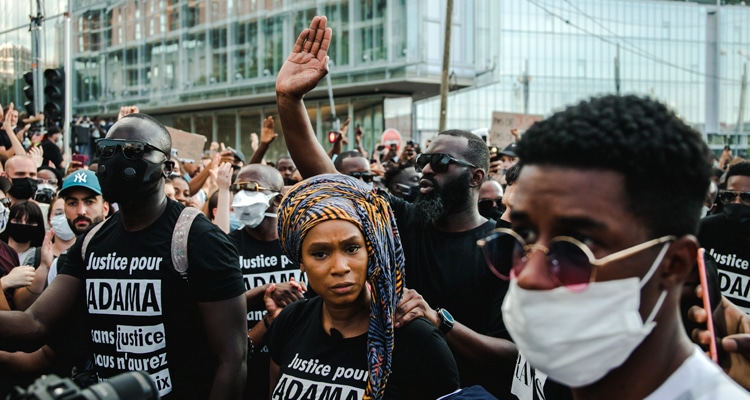Around the corner from my front door in the center of Paris is an ersatz memorial. The mural appeared just a couple of weeks ago and is a visual reminder of the millions of Black Congolese killed by the French during the period of colonization from the 1880s to independence in the 1960s to today. Its simple message, illustrated in a deliberately naive, almost school-chalkboard manner, is the English phrase, “I can’t breathe.”
This now-familiar cry of George Floyd is today a part of the French lexicon, particularly since the tragic case of Adama Traoré was revived this past summer with mass protests for justice.
On July 19th, 2016, Traoré died on his 24th birthday in a police station. The son of an African immigrant from Mali, Traoré had been taken into custody following a police identity check. He died from asphyxiation. Over the course of hours, and then days, following his detention, his family was given misleading and contradictory explanations as to the circumstances of his arrest, detainment, and eventual death. One of the gendarmes who was present said his last words were that he couldn’t breathe.
The parallels between the George Floyd death and Adama Traoré’s were so striking that on May 29, 2020, when French authorities absolved the police of any responsibility for Traoré’s death, over 20,000 people marched in protest.
“I can’t breathe.”
For most of the white French citizenry, police repression was finally brought into visibility during the mass protests of the Gilets Jaunes (Yellow Vests). This overwhelmingly white, middle-class, populist movement arose in 2018 against Macron’s proposed increase of the gas tax. They had never experienced firsthand the kind of police tactics that are usually reserved for the Black and Arab populations who reside in the impoverished working-class ghettos that ring Paris and other French cities. Over the course of weekly marches, the police indiscriminately beat protesters and exploded tear gas canisters (France was the only country in the European Union that used these devices, which can blow off a hand or leg if detonated too close. Their use has since been discontinued.).
In the wake of this heightened public awareness following the Gilets Jaunes protests, reports came out that contradicted the official position that these were isolated incidents, that there were only a few “bad apples” within the ranks of the police. In June of 2020, posts within a private Facebook group for French police, which had 7,240 members, were published in the national media. As reported by Kim Willsher in The Guardian: “Screenshots of the group’s page … showed comments that were racist, mocked the deaths or injuries of members of the public sustained in contact with the police, or were sexist or homophobic. In one comment posted on the group’s Facebook page after a demonstration organized by Traoré’s family last week, which attracted 20,000 people, one member wrote: ‘It was rather like an oil tanker had sunk,’ referring to the color of the protesters.”
Despite the French public’s current, newfound sensitivity to the endemic problem of police violence and racism, Macron’s government in the fall of 2020 introduced a new law that would make illegal any sharing of images showing police faces, punishable by a fine of €45,000 and jail time of up to a year. The fact that the police do not have body cameras, or any independent oversight, was not addressed.
President Macron has responded to the repeated problems within the police in an obstinately tone deaf manner, finally only saying the actual words “police violence” after repeated questioning in an interview but still disavowing that it was a systemic crisis. All 16 ministers of his newly installed government following the June 2020 Adama Traoré protests, headed by his new Prime Minister Jean Castex, are white.
On November 22, 2020, a prominent Black, French rap producer, Michel Zecler, was beaten by Paris police officers in his studio. The entire scene was captured on the security cameras in his studio, as well as by CCTV footage outside in the street. The police falsely claimed that Zecler had tried to confront the police, and that he had attempted to drag them inside, yet video evidence clearly showed that was not the case.
As luck would have it, the Zecler incident happened just as the controversial new global security law was being pushed through parliament. With the public outcry at yet another example of police obfuscation regarding the facts, as well as the images showing the pummeling Zecler received from the police, the law has been tabled for the moment, to be “revised,” according to Macron’s government.

